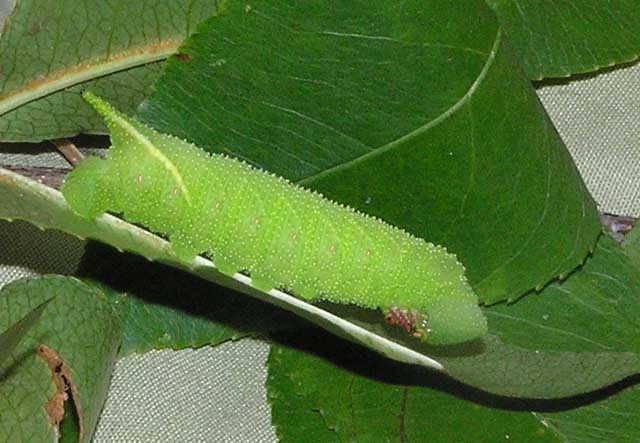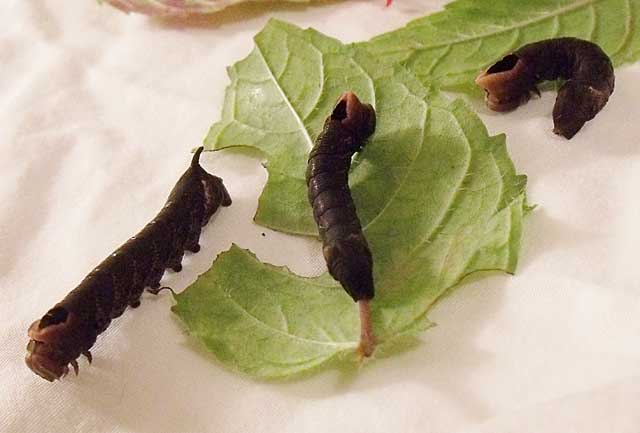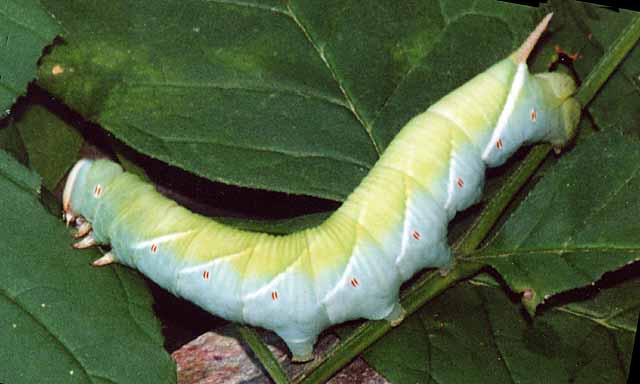Taylor County, Wisconsin
Sphingidae Larvae

|
|
Created/dedicated as per personal communication with Joan F. Rickert, August 2, 2008 Updated as per James P. Tuttle's The Hawk Moths of North America, August, 2008 |

This page is inspired by and dedicated to the Joan F. Rickert who sent me the Paonias excaecata larva top of this page. Joan has sent me many imgaes of Sphingidae adults and larvae from her home area in Medford, Taylor County, Wisconsin.
Joan writes, September 18, 2013,
"Hi Bill,
"To my surprise this evening I found three Hermit Sphinx Moth caterpillars on my monarda!!! These are the only sphinx moth caterpillars I found this season-and
Iím always looking. Sending pictures but will try and get better ones tomorrow. The last time and only time I saw one of these caterpillars was August 8, 2006.
I sent pictures to you then. It seems very late to find them. Would the moths be flying around yet? Going out to my gardens again tonight to look for more.
I plan to rear them. Can you tell from their size if they are in their last instar? Thanks for your time.
Joan Rickert"
"Hi Joan,
"Thanks for thinking of me.
"I am getting many submissions of larvae images so I think these larvae are probably just near the mature stage of the last brood of the season. I would not expect
many Sphingidae to still be flying in northern Wisconsin.
I think these are fifth instar larvae as I believe there is a dorsal horn in the first four instars. They probably just need another few days to mature.
Best of luck.
Bill Oehlke

Lintneria eremitus Medford, Taylor County, Wisconsin,
September 18, 2013, courtesy of Joan F. Rickert.
A WO" after the species name indicates that I have no confirmed reports of this species in Taylor County, but I (William Oehlke) expect that this species is present.
Please help me develop this list with improved, documented accuracy by sending sightings (species, date, location), preferably with an image, via email to Bill Oehlke.
Please also send your sightings to BAMONA, an excellent online resource, replacing USGS.
Visit Taylor County Sphingidae: Adult Moths.
Visit Wisconsin Catocala: Underwing Moths.
Sphinginae subfamily
Immatures and mature larvae, August 2006, Medford, Joan F. Rickert.
Smerinthini Tribe:
Macroglossinae subfamilyDilophonotini Tribe:
See Hemaris comparison to help distinguish the next three species.
Philampelini Tribe:
Macroglossini Tribe:
|

Eggs of many North American species are offered during the spring and summer. Occasionally summer Actias luna and summer Antheraea polyphemus cocoons are available. Shipping to US destinations is done from with in the US.
Use your browser "Back" button to return to the previous page.
This page is brought to you by Bill Oehlke and the WLSS. Pages are on space rented from Bizland. If you would like to become a "Patron of the Sphingidae Site", contact Bill.
Please send sightings/images to Bill. I will do my best to respond to requests for identification help.
 Show appreciation for this site by clicking on flashing butterfly to the left. The link will take you to a page with links to many insect sites. |
I very much appreciate all the many images that have been sent to me, or of which I have been granted permission to copy and post from other websites. All images on this site remain the property of respective photographers.
If you would like to contribute to the maintenance of this website by sending a contribution to
Bill Oehlke
Box 476
155 Peardon Road
Montague, Prince Edward Island, C0A1R0
Canada
your donation would be much appreciated and would be used for
1) paying for webspace rental;
2) paying for computer maintenance and software upgrades;
3) purchases of additional text reference material (journals and books) in anticipation of expanding the site to a worldwide Sphingidae site;
4) helping to pay my daughter's tuition (completed spring of 2013); with anything left over going to humanitarian aid.
If you are mailing a check from USA, please use $1.25 (2019 rate) postage. Donations can also be made through Paypal via the button below.